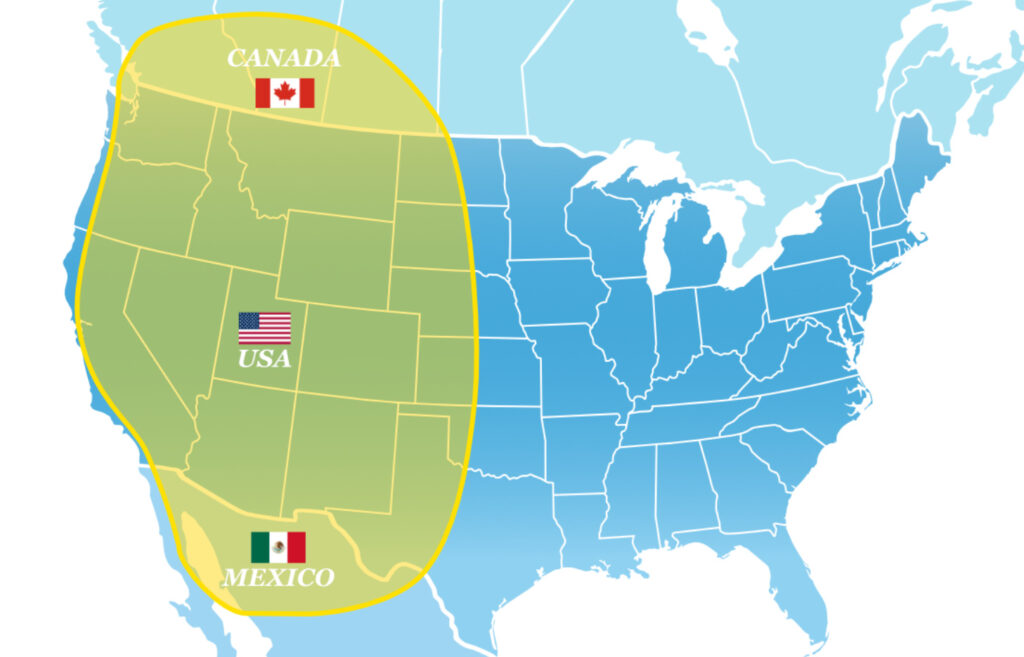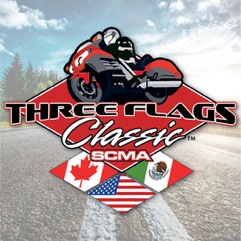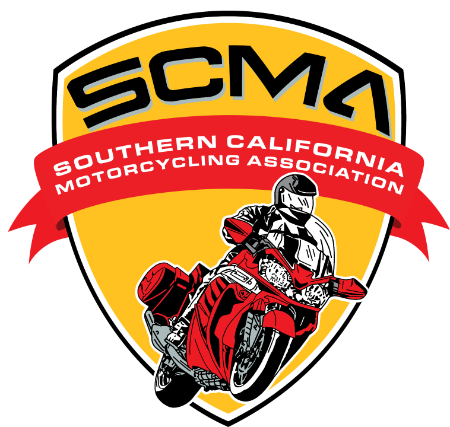Three Flags Classic

Since 1976
Signature ride offering for the SCMA and the most popular event in SCMA catalog.
Our longest running annual motorcycle ride.
Make lifelong friends and riding companions.
See the west via secondary roads rather than interstate.
Build your own route.
4-5 day ride from Mexico to Canada or the reverse.
Join the Annual Ride from Mexico to Canada Over Labor Day Weekend
The Three Flags Classic (TFC) is one of the SCMA’s signature events and it’s on Labor Day Weekend. It’s one of the events we are known for in addition to the USA Four Corners Tour. During the 40+ years the routes have been all over the yellow highlighted area above.
Three Flags Classic
 Every year the route is different and most often it starts in Mexico or near the border on the Friday of Labor Day Weekend. It runs the 2100 miles or so through 3 or 4 required checkpoints on the recommended route into Canada finishing on Monday, Labor Day. A “Finish” banquet is held the following evening to celebrate the current year and past accomplishments of riders who have completed the event many times. The fun starts when you arrive at the starting location, check-in to receive your ride Passport and starter’s kit and attend the “Start” banquet. The event is challenging but doable and provides a sense of accomplishment after passing through parts of the West you probably haven’t seen yet. We do focus some events on First Time Riders and everyone else is happy to see the friends they made last time and meet new ones.
Every year the route is different and most often it starts in Mexico or near the border on the Friday of Labor Day Weekend. It runs the 2100 miles or so through 3 or 4 required checkpoints on the recommended route into Canada finishing on Monday, Labor Day. A “Finish” banquet is held the following evening to celebrate the current year and past accomplishments of riders who have completed the event many times. The fun starts when you arrive at the starting location, check-in to receive your ride Passport and starter’s kit and attend the “Start” banquet. The event is challenging but doable and provides a sense of accomplishment after passing through parts of the West you probably haven’t seen yet. We do focus some events on First Time Riders and everyone else is happy to see the friends they made last time and meet new ones.
Three Flags Classic History
The Three Flags Classic was created by the larger-than-life SCMA member and SCMA leader Joe Usatin. In 1976, he was inspired by reading about the trail blazing motorcycle riding of Erwin G. Baker aka Dee Baker aka “Cannon Ball” Baker. In addition to his record-breaking US transcontinental motorcycle run in 1914, Baker also set a record in 1915 riding from Canada to Mexico “touching three countries.”
The story below that looks back in time is from an article written about the Three Flags Classic that was distributed to riders in the 1980s when the ride was a little different:
The original “Three Flags Ride” was made in 1915 by Dee “Cannonball” Baker. Starting from Vancouver, Dee Baker battled his way through a horror of a route. (At this time, pavement was only an idea and gasoline was sold at the general store from drums). After eighty-one hours and fifteen minutes of dirt, mud, ruts, and potholes, E.G. Baker crossed the border into Tijuana, and the “Three Flags Ride” became part of Motorcycle History.
On August 24, 1915, EG Baker, riding an Indian motorcycle equipped with the new type 1916 Indian motor, left Vancouver, British Columbia. It was the beginning of his “Three Flags Ride” through three countries (Canada, United States, and Mexico). Less than three and one-half days later, after a run down the Pacific Coast through the States of Washington, Oregon, and California, he checked into Tijuana, Mexico.
Conquering five mountain ranges, dashing through four miles of forest fire and slashing through roads worse than those of his transcontinental ride, “Bake” laid down a record for himself and the new Indian Motor which is the truly amazing performance of the year.
The motor that Baker drove will be standard on the 1916 Indian. It will be the big surprise of the 1916 season. You won’t be satisfied with anything less when you see it. Big announcement coming soon.
The challenge presented by this ride caused a number of individualists to try to beat Mr. Baker’s riding time. Progress, particularly in California, soon brought speed control laws, and pressure was brough to bear on these intercontinental road races. Around the quarter century mark, Wells Bennett spend ten hours in a Medera count jail. This was just long enough to thwart his attempt to break the record time. The Three Flags Ride soon faded into the mists of history.
Five decades later, Fred Chase rode his 1000cc Honda Goldwing over the original route in 18 hours and 15 minutes. He was using the most sophisticated radar sensing device available to help him in this highly “illegal” re-make of the “Original Ride.”
In the same year (1976), “Joe Usatin” had a more practical idea. He turned the route around– began at the Mexican end with a group of dedicated tourists, and followed the original route northward – keeping to the “legal” speed limits. This was the beginning of what we now know as the “Three Flags Classic.”
In 1977, the Southern California Motorcycling Association (an affiliation of numerous individual motorcycle clubs) became actively involved with the organization and operation of the “CLASSIC.” Since that time, the Three Flags Classic has blossomed into the world’s longest touring event for motorcyclists of all nationalities.
For further clarification or questions about the Three Flags Classic, contact:
Ride Chair – Mark Burdick
info@sc-ma.com
The Parking Lot Narrative of The Three Flags Classic
You have probably heard of an “elevator story,” which is a concise and compelling explanation of something important you want to share with someone else. This is the short description of the Three Flags Classic often delivered in parking lots, not elevators, by some of our long-time members, but it could be recited anywhere. It goes like this:
It’s a motorcycle ride, a long-distance tour. It’s not a contest and there is no prize. It takes place over the Labor Day Weekend in the US running from Mexico to Canada or Canada to Mexico. Occasionally in the past it would be run on Thursday through Monday instead of Friday through Monday and now it’s the 5-day length every five years.
It’s not hard at about 2100 total miles that’s 525 miles per day for 4 days. The route given provides your first look at places you might want to see later with the family in the car.
The registration is capped at 300 people, and they don’t dash out of the gate all at once. You can pick who you want to ride with based on who rides like you. In the early days there was a sticker that identified who else was riding the ride. Nowadays we tie the hi visibility plastic surveyor’s tape tied on the back of the bike. You will likely see other riders on the route.
The biggest prize is the people you meet and the routine to return year after year to enjoy the people and the event.
